Today AMD releases their Flagship Phenom 2 955 BE designed for the AM3 platform and DDR3 coming in at a blistering 3.2 GHz and OC ready. Expect speeds up to 4 GHz on Air.
INTRODUCTION
We’ve been waiting a few weeks to tell you about the AMD Phenom 2 X4 955 BE. We can’t tell you how hard it is not to leak information about products like the Phenom 2 X4 955 BE. Here we are sitting on a top CPU, seeing it run unbelievable numbers on the benches and overclocking like a champion, then having to keep it secret until launch day. We guess it’s a necessary thing to coordinate the launch of new products but it’s really hard to be sitting on the top product in a category and not be able to tell people.
April 23rd 2009 seemed to approach at a snails pace but finally the day is here where we can release information on the new Phenom 2 X4 955 BE and its unlocked processor. You should be seeing it on E-Tailer shelves as of today. This isn’t a paper launch. The processor is immediately available on retail sites and vendors have them on hand, ready to ship should you be lucky enough to be waiting on a new AM3 processor. The Phenom 2 X4 955 BE, of course, is backwards compatible with the AM2+ platform, which is one of the exciting things about the new quads. You can upgrade while still holding onto your existing AM2+ and enjoy the benefits of a relatively inexpensive unlocked CPU and upgrade to AM3 and DDR3 at your leisure.
The higher performance and overclockability of the new Phenom 2 X4 lineup, combined with lower upgrade costs than the competition, makes the Dragon platform an attractive choice in these economic hard times. Economically speaking, the times may be hard but AMD has shown you can produce an affordable platform with out sacrificing performance. This move not only allows users to enjoy a high end platform but shows that AMD cares about the end user by keeping the prices down. Kudos AMD!

About AMD
Advanced Micro Devices (NYSE: AMD) is an innovative technology company dedicated to collaborating with customers and partners to ignite the next generation of computing and graphics solutions at work, home, and play.
Vision
A world where the amazing power of AMD technology improves the quality of people’s lives.
AMD set a goal to enable affordable, accessible Internet connectivity and computing capabilities for 50 percent of the world’s population by the year 2015. Learn more about AMD’s 50×15 Initiative.
Mission
Lead through innovative, customer-centric solutions that empower businesses, enhance the digital lifestyle, and accelerate global digital inclusion.
Values & Beliefs
AMD’s culture is characterized by an indomitable will to succeed and prosper in one of the world’s most challenging industries. At the heart of our unique and strong culture is the belief that people are the ultimate source of our competitive advantage. By living these core values, each one of us helps to deliver on our promises to customers, maximize shareholder value and ensure our enduring success.
Respect for People
We respect people, honor diversity and treat each other fairly. These are the cornerstones of our culture and key to our ability to work successfully as a global team. Learn about what it’s like to work at AMD.
Integrity
We operate with the highest standards of honesty and responsibility—as individuals and as a corporation—to be a role model worldwide through our business practices, community involvement and environmental stewardship. View our corporate responsibility mission and achievements.
Our Customers’ Success
We ensure our customers’ ongoing success by forging deep relationships founded on our commitment to meet their diverse technology needs and a shared passion for excellence. Read about how AMD drives customer success.
Customer-Centric Innovation
We lead through innovation—championing creative ideas and solutions that enable our customers to truly differentiate their solutions in the marketplace.
Initiative and Accountability
We deliver on our promises to our customers, stakeholders and to each other by taking risks, seeking proactive solutions and assuming ownership of the results.
At AMD, we take a measured approach to evaluate and continually improve global environmental efficiency, from how we run corporate facilities to how we develop products that deliver superior performance-per-watt. Learn more about AMD’s Green initiative at: www.amd.com/climate.
Fair and Open Competition
We believe that fair and open competition places the freedom of choice in the hands of customers, allowing the widest population to have access to the best possible technology.
| CPU Name | Cores | Clock | L2/L3 Cache | HT Bus | Socket | TDP | Price |
| AMD Phenom II X4 965 BE | 4 | 3.4GHz | 2+6MB | 4000MHz | AM3 | 140W | $179 |
| AMD Phenom II X4 955 BE | 4 | 3.2GHz | 2+6MB | 4000MHz | AM3 | 125W | $165 |
| AMD Phenom II X4 945 | 4 | 3.0GHz | 2+6MB | 4000MHz | AM3 | 125W | $159 |
| AMD Phenom II X4 925 | 4 | 2.8GHz | 2+6MB | 4000MHz | AM3 | 95W | $139 |
| AMD Phenom II X4 910e | 4 | 2.6GHz | 2+6MB | 4000MHz | AM3 | 65W | $169 |
| AMD Phenom II X4 905e | 4 | 2.5GHz | 2+6MB | 4000MHz | AM3 | 65W | $175 |
| AMD Phenom II X4 810 | 4 | 2.6GHz | 2+4MB | 4000MHz | AM3 | 95W | $139 |
| AMD Phenom II X3 720BE | 3 | 2.8GHz | 1.5+6MB | 4000MHz | AM3 | 95W | $104 |
| AMD Phenom II X3 710 | 3 | 2.6GHz | 1.5+6MB | 4000MHz | AM3 | 95W | $99 |
| AMD Phenom II X3 705e | 3 | 2.5GHz | 1.5+6MB | 4000MHz | AM3 | 65W | $119 |
| AMD Phenom II X2 555 | 2 | 3.2GHz | 1+6MB | 4000MHz | AM3 | 80W | $99 |
| AMD Phenom II X2 550 | 2 | 3.1GHz | 1+6MB | 4000MHz | AM3 | 80W | $91 |
| AMD Athlon II X4 635 | 4 | 2.9GHz | 2MB | 4000MHz | AM3 | 95W | $120 |
| AMD Athlon II X4 630 | 4 | 2.8GHz | 2MB | 4000MHz | AM3 | 95W | $102 |
| AMD Athlon II X4 620 | 4 | 2.6GHz | 2MB | 4000MHz | AM3 | 95W | $99 |
| AMD Athlon II X3 440 | 3 | 3.0GHz | 1.5MB | 4000MHz | AM3 | 95W | $84 |
| AMD Athlon II X3 435 | 3 | 2.9GHz | 1.5MB | 4000MHz | AM3 | 95W | $75 |
| AMD Athlon II X3 425 | 3 | 2.7GHz | 1.5MB | 4000MHz | AM3 | 95W | $72 |
| AMD Athlon II X2 255 | 2 | 3.1GHz | 2MB | 4000MHz | AM3 | 65W | $75 |
| AMD Athlon II X2 250 | 2 | 3.0GHz | 2MB | 4000MHz | AM3 | 65W | $65 |
| AMD Athlon II X2 245 | 2 | 2.9GHz | 2MB | 4000MHz | AM3 | 65W | $61 |
| AMD Athlon II X2 240 | 2 | 2.8GHz | 2MB | 4000MHz | AM3 | 65W | $53 |
FEATURES
Major feature enhancements for 45nm AMD Phenom II:
- Enhanced Total Cache: 8MB (Total Cache)
- Cool’n’Quiet 3.0 Technology: Additional power states, significantly (~40%) lower idle power and lower power consumption under moderate loads
- Increased frequencies
- Massive headroom using extreme and experimental cooling techniques
Major silicon enhancements for 45nm AMD Phenom II:
- 45nm immersion lithography manufacturing technology enables higher frequencies, tighter tolerances and lower current leakage
- 6MB L3 cache (up from 65nm Phenom’s 2MB)
- 2-cycles faster than 65nm Phenom L3
- Increased DRAM bandwidth
- Cache flush on halt: Core’s L1 and L2 flush into shared L3 after a core enters a halt state allowing the core to drop to a lower speed and save power
- Path-based indirect branch prediction
- 2x increase in core probe bandwidth
- Larger load/store buffering / larger floating point buffering / reduced MAB (missed buffer) lifetime
- Improved LOCK pipelineing: (LOCK is an instruction prefix) this improves performance when multiple LOCKS are in process simultaneously
- FP MOV compute optimization: Floating point register-to-register move instruction improvements
Phenom 2 Dragon Platform Aspect
As you probably already know, AMD is the only CPU manufacturer that can field its own world class GPU’s and CPU’s, which gave birth to the Dragon Platform concept, a fusion of GPU and CPU, manufactured and designed to compliment each other. While this is a CPU performance review we will be covering the Graphics end of the Dragon Platform in yet another review of this new platform. In the mean time, we wanted to touch on some of the Dragon Platform aspects.
Video Processing on a Radeon GPU:
Continuing on the topic of platform-level performance analysism ATI has just released new Catalyst 9.3 drivers (for Windows and Linux) and a new version of AVIVO which provides a powerful tool for video processing. ATI Stream uses the massive parallel processing power of AMD graphics processors to deliver new capabilities to users that go beyond the traditional usage scenarios of graphics rendering and video processing.
Benefits:
- ATI Stream harnesses the processing power of the GPU for high-performance, data-intensive computations over a wide range of applications
- ATI Stream enables the hundreds of parallel cores inside AMD GPUs to accelerate general purpose applications
- These capabilities will allow ATI Stream-enabled programs to operate with optimized performance (or with new functionality) for a variety of different tasks and from a growing number of software vendors
- The CAL (Compute Abstraction Layer) is now included in the Catalyst driver package. CAL is the enabling component for ATI Stream
- Every owner of an ATI Radeon HD 4000-series card automatically gains the ability to run ATI Stream enabled applications
- Growing number of developers set to deliver ATI Stream enabled applications
ATI Stream application: ATI Avivo Video Converter
- Free download
- Low complexity, high value application
- Dramatically accelerates conversion of video files
- Optimized for file sizes common to HD video
Using ATI Stream technology, owners of ATI Radeon HD 4000-series graphics cards can take advantage of this video conversion tool (find it in Catalyst Control Center’s “Basic View”) to achieve incredible performance levels in video transcoding. We strongly urge you to test ATI Stream during your platform evaluation. You might consider it for an addition to your standard test suite. It should prove useful to test and quantify our raw performance, video processing prowess, and demonstrating the platform benefits of Dragon platform technology.
Upcoming AM3 Phenom II processors:
The AMD Phenom II X4 955 BE processor, launching in April 2009, are socket AM3 backwards compatible with AM2+ and support DDR2 memory on AM2 + and DDR3 on AM3. These new AM3 processors are compatible with both the current socket AM2+ and AM3, supporting both DDR2 and DDR3. This approach allows users, businesses, system builders, and OEMs to migrate across memory technologies at their own pace, when the time is right. AMD’s approach continues to be one of flexibility and compatibility to maximize platform longevity. In the current economic climate, we believe this approach makes more sense than ever.
Some Overclocking Tips (Black Edition)
Finding the maximum potential of your CPU is fairly straight forward with a “Black Edition” processor and the latest version of AMD OverDrive on a platform like the AMD 790GX-based motherboard which you’ll want to use with your processor. Here is some basic guidance to help get you on your way to voiding your warranty. Just remember, as always, “your mileage may vary.” Some chips will overclock better than others, but regardless… you roll the dice when you try. You can find the latest version of AMD Overdrive: http://game.amd.com/us-en/drivers_overdrive.aspx?p=1
Basic Overclocking Steps
- Increase CPU multiplier
- Use the HT reference clock slider in steps of 1-to-3 MHz for fine tuning (for less than 50MHz steps in CPU core clock)
- Increase CPU Voltage (VID)
Voltage Adjustment
By default, the CPU voltage slider (CPU VID) in AMD OverDrive maxes at 1.45V. You can extend it to the max VID value of 1.550V by editing the “Preference.xml” file (with notepad.exe) in the AOD installation folder. Just find “MaxVcoreEnabled” and change it from “0” to “1”
Depending on the CPU and the cooling solution, the optimal voltage can be anything between 1.40V (an air-cooled part that prefers low volts) and 1.95V (liquid nitrogen at -196C… assuming your processor demonstrates good voltage scaling).
For air-cooling our experts recommend testing from 1.40V up to 1.55V in 0.05V steps in order to find the optimal voltage
NOTE: its quite possible that you start seeing negative scaling after certain voltage point. Remember, every CPU can be a little different
The only things you might want to adjust in the BIOS while overclocking are:
- Disable Cool’n’Quiet
- Disable C1E
- Disable Spread Spectrum
USING EXTREME COOLING (Liquid Nitrogen / Liquid Helium / etc.):
Here’s a tip if you’ve already hit ~5GHz and are looking for even more overclocking headroom with EXTREME cooling. For temperatures below the -70 to -100°C mark we suggest switching the CPU to HT 1.0 mode. Just adjust the “HT Link multiplier” item in the BIOS menu to “1GHz (x5)” mode. The CPU NB clock can still run at default (or overclocked) value – just the HT Link interface requires this adjustment for optimal temperature margin. As per the experience of our internal team, most CPUs overclock well at -190°C using HT1.0 settings. To get the best overclock possible, try setting HyperTransport to HT1 mode. This does not mean that HT Link must run at only 1.0GHz. You can tweak the HT reference clock to higher than the 200MHz default value which will increase the HT Link frequency and HT bandwidth. Try gradually working up with incremental jumps with an eye for a 300MHz HT reference clock (if possible with your chip). This would give a 1.5GHz HT Link speed.
HT3.0 Settings:
Though HyperTransport 3.0 is capable of higher frequencies than the northbridge/memory controller runs at, for best operation and performance, the HT speed should always be set to the SAME FREQUENCY as the memory controller specification for the particular CPU being tested. This can be done in the BIOS or in AMD Overdrive… or just left as-is (default settings) with proper BIOS support.
Example: the HT frequency for systems with the Phenom II X4 940 and 920 processors should be run at 1.8GHz, again the same frequency as the memory controller
DISCLAIMER
While Bjorn3D.com and AMD try to provide information as accurate as possible OCing is a crap shoot. Bjorn3D.com and AMD accept no responsibility for any attempt at OCing or any attempt at (what we have termed) Bone Head Stunts. No guarantee exists that you will be able to OC, or that your part will OC at all. It’s a crap shoot. OCing is a combination of carefully selected parts and OCing skill. As usual the contents on this site are provided “as is” without express or implied warranty.
In no case or special event shall Bjorn3D.com or AMD be held responsible for indirect or consequential damages or any damages whatsoever resulting from loss of income or profits, whether in an action of contract, negligence or other tortuous action, arising in connection with the use or performance of this information.
Bjorn3D has provided a number of links to external sites as a service to our readers, this should not be construed as any link between us and any entity or individual nor can we be held responsible for any content on their site.
Bjorn3D.com reserves the right to alter amend or delete any content without further notice.
Any reproduction of information from this site in partial or full is strictly prohibited and will result in legal action unless you have prior written permission from the site owner, or Management Staff.
With that being said: Let the Bone Head Stunts Begin
AMD Phenom X4 CPU Specifications
| AMD Phenom II X4 955 BE Specifications |
|
| Processor Frequency |
X4 955 (Black Edition) = 3.2GHz |
| Cache Sizes | L1 Cache Sizes: 64K of L1 instruction and 64K of L1 data cache per core (512KB total L1 per processor)
L2 Cache Sizes: 512KB of L2 data cache per core (2MB total L2 per processor) L3 Cache Sizes: 6MB (shared) |
| Memory Controller Type: | Integrated 128-bit wide memory controller * (See Note) |
| Memory Controller Speed | Up to 2.0GHz with Dual Dynamic Power Management |
| Types of Memory Supported | Support for unregistered DIMMs up to DDR2-1066MHz or PC3 DDR3-1333 (See Note) |
| Memory Bandwidth | Up to 21.3GB |
| HyperTransport 3.0 Link | One 16-bit/16-bit link @ up to 3.6GHz full duplex (1.8GHz x2) |
| HyperTransport 3.0 Bandwidth | Up to 16.0GB/s |
| Total Processor Bandwidth | Up to 37.3 GB/s total bandwidth |
| Packaging | Socket AM2+ 940-pin organic micro pin grid array (micro-PGA) |
| Fab location | Fab 36 wafer fabrication facilities in Dresden, Germany |
| Process Technology | 45-nanometer DSL SOI (silicon-on-insulator) technology |
| Approximate Transistor count | ~ 758 million (45nm) |
| Approximate Die Size | 258 mm2 (45nm) |
| Max Ambient Case Temp | 62o Celsius |
| Nominal Voltage | 0.875 – 1.5 Volts |
| Max TDP | 125 Watts |
| NOTE: * MC configurable for dual 64-bit channels for simultaneous read/writes | |
While the officially supported speeds of memory are DDR2 1066 MHz for AM2+ and DDR3 1333 MHz for AM3, we’ve run memory on the AM2+ up to and beyond 1200MHz and on the AM3 platform up to and including 2 GHz, so if you crave some faster speed RAM you can use it. It might take some tinkering to get it running correctly, but you can use it.
Phenom 2 General Specifications
| AMD Phenom II X4 + X3 (AM3 Package Backwards Compatible AM2+) Specifications |
|
| Processor Frequency | X4 810 = 2.6 GHz 4MB L3 X3 720 Black Edition 2.8GHz 6MB L3 X3 710 = 2.6GHz 6MB L3 X4 910 = 2.6GHz 6MB L3 X4 805 = 2.5GHz 4MB L3 |
| Cache Sizes | L1 Cache Sizes: 64K of L1 instruction and 64K of L1 data cache per core (512KB total L1 per processor)
L2 Cache Sizes: 512KB of L2 data cache per core L3 Cache Sizes: 6MB (shared) or L3 Cache Sizes: 4MB (shared) |
| Memory Controller Type: | Integrated 128-bit wide memory controller * (See Note) |
| Memory Controller Speed | Up to 2 GHz with Dual Dynamic Power Management |
| Types of Memory Supported | Support for unregistered DIMMs up to PC2 8500 (DDR2-1066MHz) AM2+ Board Support for unregistered DIMMs up to PC3 10666 (DDR3-1333MHz) AM3 Board |
| Memory Bandwidth | Up to 17.1GB |
| HyperTransport 3.0 Link | One 16-bit/16-bit link @ up to 4.0 GHz full duplex (2.0GHz x2) |
| HyperTransport 3.0 Bandwidth | Up to 16 GB/s |
| Total Processor Bandwidth | Up to 33.1 GB/s total bandwidth |
| Packaging | Socket AM2+ 940-pin organic micro pin grid array (micro-PGA) or Socket AM3 938-pin organic micro pin grid array (micro-PGA) |
| Fab location | Fab 36 wafer fabrication facilities in Dresden, Germany |
| Process Technology | 45-nanometer DSL SOI (silicon-on-insulator) technology |
| Approximate Transistor count | ~ 758 million (45nm) |
| Approximate Die Size | 258 mm2 (45nm) |
| Max Ambient Case Temp | 71o Celsius / X4 73o Celsius / X3 |
| Nominal Voltage | 0.875 – 1.425 Volts |
| Max TDP | 125 and 95 Watts (Varies by model) |
| NOTE: * MC configurable for dual 64-bit channels for simultaneous read/writes **NOTE: for DDR3-1333, AM3 boards will support 1-DIMM-per-channel @ 1333MHz |
|
Individule CPU Specifications
| AMD CPU Specs | ||||||||
| Model | Clock Speed | System Bus Speed | Package Profile | Voltage | Max Temp | TDP | Total L2 Cache | Total L3 Cache |
| 955 X4 (Black Edition) | 3.2 GHz | 4.0 GT/s | Socket Am2+ or Am3 | 0.875-1.5v | 62°C | 125w | 2MB | 6MB |
| 940 X4 (Black Edition) | 3.0 GHz | 3.6 GT/s | Socket AM2+ | 0.875-1.5v | 62°C | 125w | 2MB | 6MB |
| 920 X4 | 2.8 GHz | 3.6GT/s | Socket Am2+ | 0.875-1.5v | 62°C | 125w | 2MB | 6MB |
| 810 X4 | 2.6 GHz | 4.0 GT/s | Socket Am2+ or AM3 | 0.875-1.425v | 71°C | 95w | 2MB | 4MB |
| 910 X4 | 2.6 GHz | 4.0 GT/s | Socket Am2+ or AM3 | 0.875-1.425v | 71°C | 95w | 2MB | 6MB |
| 805 X4 | 2.5 GHz | 4.0 GT/s | Socket Am2+ or AM3 | 0.875-1.425v | 71°C | 95w | 2MB | 4MB |
| 720 X3 (Black Edition) | 2.8 GHz | 4.0 GT/s | Socket Am2+ or AM3 | 0.875-1.425v | 73°C | 95w | 2MB | 6MB |
| 710 X3 | 2.6 GHz | 4.0 GT/s | Socket Am2+ or AM3 | 0.875-1.425v | 73°C | 95w | 2MB | 6MB |
PICTURES & IMPRESSIONS
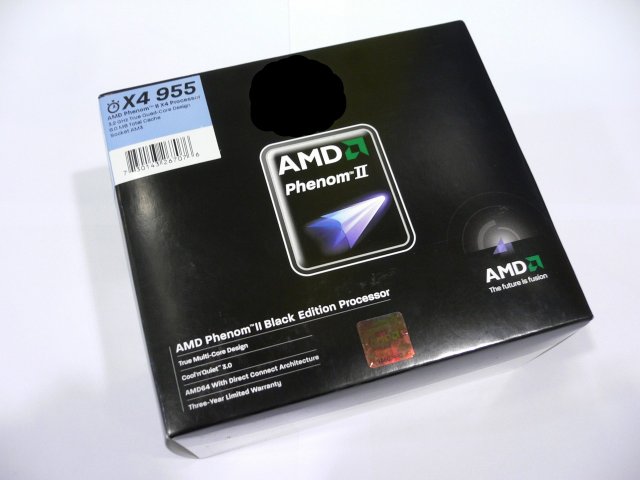
While we didn’t receive a retail box processor for testing we wanted to show you what it was going to look like. AMD has gone with their typical Black Edition black box packaging for the flagship Phenom 2 955 BE.

Featuring a total of 8 MB and a clock speed of 3.2 GHz, this is the fastest out of the box Phenom 2 X4 yet. If the overclock speeds are anything like the Phenom 2 X4 940 (AM2+ only) chip you can soon expect to see extreme cooling overclockers setting new world records with the X4 955 BE. We’re betting some insane person somewhere tops 6 GHz with this puppy.
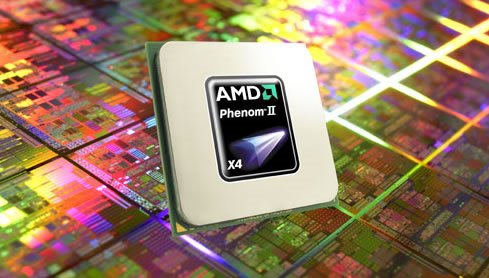
See in front of the DIE the CPU’s are cut from we snagged this press shot of the Phenom X4 from the AMD FTP site.

Pictured on the black background you can see that it’s pretty typical (as far as looks go) for a normal AMD CPU. Integrated Heat Spreader covering almost the entire chip and gold “Insert this direction” indicator.
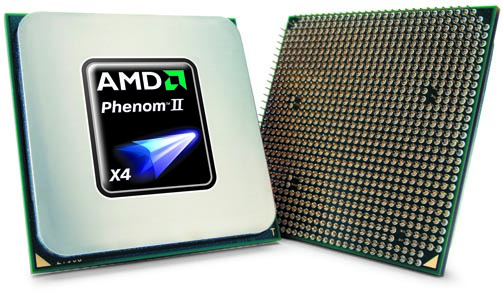
Looking at the back of the chip you can see it’s AM3 and backwards compatible with AM2+ and the pin pattern reflects that.
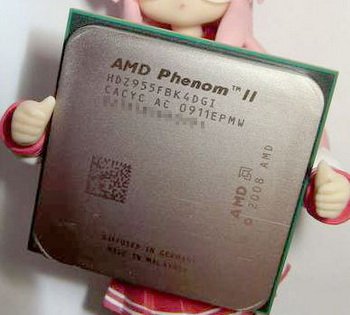
Then, finally the chip itself. The HDZ955FBK designation lets you know that it is indeed a Phenom 2 X4 BE. Processors aren’t made for pictures, they’re made to run. So let’s move into the Testing and Methodology section and get right into benchmark results.
TESTING & METHODOLOGY
To test the Phenom 2 CPU’s we did a fresh load of Vista 64 and applied all the latest patches and updates. We also updated the motherboard drivers to the latest versions and checked to make sure we were using the latest BIOS. Once we had all the patches installed, motherboard drivers up to date, and all the little things that need to be done to bring a system up to snuff, we cloned the drive using Acronis to keep the load safe from any little overclocking accidents we might have.
Speaking of overclocking accidents, we thought we’d privy you to a little information about that on this review. We tend to get in a hurry and when you do that things happen. We bricked at least two OS installs overclocking a little too aggressively. No fault of the equipment we assure you, but overclcoking accidents happen, which is why we clone with Acronis and encourage anyone OCing to do the same. That spare drive that might cost you $50 is pretty cheap compared to reloading the OS 3 or 4 times during an extended overclocking session.
Along the same lines, on this review in particular, the overclocks we managed are more a reflection of the amount of time that we had to spend with the product before the NDA (Non-disclosure agreement) lifts than the equipment itself. By that we mean two weeks spent with the New Phenom 2 CPU’s (three of them) and a new never before used motherboard isn’t enough time to say, “These are the maximum OC’s we achieved and we believe that these are the best overclocks we can get.” We know they’re not the best OC’s we can get but they are the best OC’s we can get in the allotted time we had with the product before it was time to post the review. With more time and experience on the platform and motherboard we know we can achieve higher overclocks so please take that into consideration.
Test Rigs
We decided that since no matter what we do or say that the information about the review of Intel and AMD CPU’s people are going to look at them side by side and draw conclusions. To that end we used the same CPU cooler on all of the CPU’s. We used the Thermalright Ultra 120 with the same two fans for every CPU. We also used the Intel 80 GB Solid State Drive for every CPU reviewed. We also used the 4870X2 for all of the data obtained in this review on every CPU.
We used the same hard drive, same CPU cooler, and same GPU on all the platforms in an attempt to make the data as relevant as possible. We don’t think that it would be a fair comparison to use a high end SSD on the Intel platform and one of the top CPU coolers without extending the same courtesy to the AMD platform. To do so would make it a lopsided review and bias the numbers. So if you browse other CPU reviews one of the things you should be looking for and asking yourself is, “Did the site use the Intel review kit items for all the CPU’s or did they use a traditional platter drive for the AMD CPU’s?” If they did, it will make a tremendous difference in the platform numbers. We tested with and without SSD and the difference was large enough to invalidate data obtained using a platter drive against an SSD. To that end, we used the same hard drive, CPU cooler, and GPU on all of the CPU’s contained in this review.
Hardware Common To All The Test Rigs
- Thermaltake Tough Power 1200 Watt
- Intel 80 GB SSD
- Palit 4870×2
- Razer Lycosa
- Razer Lachesis
- Top Deck Testing Station Chassis
- Thermalright Ultra 120 w/2 83CFm Yate Loon Fans
- LG DVD/RW
So you can pretty much see that the only platform differences are going to be Motherboard, CPU, and RAM. In a cross platform test that’s about as good as you can get.
Platform Specific Hardware
- Phenom 2 X4 955 BE CPU Equipment
- Asus M4A78T-E
- Kingston HyperX DDR3 1600 (Run at 1333) 4 GB Kit
- For more information on the Asus M3A78-T you can visit the Asus Website Here
- Phenom 2 X4 940 BE CPU Equipment
- MSI DKA790GX Platinum
- Crucial Ballistix DDR2 1066 4 GB Kit
- For more information on the MSI DKA790GX Platinum you can visit the MSI Website Here
- Phenom 2 X4 810 and X3 720 BE CPU Equipment
- Asus M3A78-T
- Crucial Ballistix DDR2 1066 4 GB Kit
- For more information on the Asus M3A78-T you can visit the Asus Website Here
- Intel Core I7 965 Equipment
- Asus P6T Deluxe
- Kingston HyperX Triple Channel DDR3 2 GHz
- For more information on the Asus P6T Deluxe you can see our review Here
- For more information on the Core i7 965 you can see our review Here
- Intel Q6600 Equipment
- EVGA 790I
- Crucial Ballistix DDR3 1333 4 GB Kit
- For more information on the EVGA 790I you can see our review Here
- Intel E8400 Equipment
- Gigabyte EP45-Extreme
- Crucial Ballistix DDR2 1066 4 GB Kit
- For more information on the Gigabyte EP45-Extreme you can read our review Here
We ran the Phenom 2 X4 955 BE memory at 1333 MHz even though the platform is fully capable of running the RAM at 1600, because that’s the rated speed the platform is built for. That, and it would be a sneak peek at the upcoming Kingston HyperX DDR3 1600 review if we released those numbers now.
Just in case you were wondering, yes, we have all those beautiful machines here in one spot, up and running, not in the configuration we used in this review but, yes ,they are all here in one spot running and fully functional, along with a stack of GPU’s that would make a grown man cry, and a stack of high end RAM that would make you pull your hair out, and a stack of high end Hard Drives that will make you drool. We were deprived as children. We had the Atari console. We’re making up for it now.
Before we move onto the Testing Suite section lets get this out of the way. We ran all the CPU’s at stock Speed during testing, then we ran the AMD CPU’s at the best OC we could get in the time we had. We already know that some people are going to yell because we didn’t OC the Intel CPU’s in the review. If you want to see the Intel overclocks and results of those we have separate reviews for three of the Intel Core I7 CPU’s, each one contains OC information and testing. Feel free to browse those and compare numbers to this review. You can spend half a lifetime OCing and charting results in all the possible combinations. We run each CPU at stock speed for comparison purposes, then the CPU being reviewed we OC that one. You might not even get an OC out of the same model CPU and unless it’s on the same board with the same RAM and the OC is done identically, the numbers won’t be the same.
Test Suite
|
Synthetic Benchmarks |
|
3DMark Vantage v. 1.01 |
|
3DMark06 v. 1.1.0 |
|
SiSoft SANDRA XII Professional SP2 |
|
Everst Ultimate Edition v. 4.50.1330 |
|
Cinebench R10 64 bit |
|
WinRar v. 3.71 |
3DMARK06 V. 1.1.0

3DMark06 developed by Futuremark, is a synthetic benchmark used for universal testing of all graphics solutions. 3DMark06 features HDR rendering, complex HDR post processing, dynamic soft shadows for all objects, water shader with HDR refraction, HDR reflection, depth fog and Gerstner wave functions, realistic sky model with cloud blending, and approximately 5.4 million triangles and 8.8 million vertices; to name just a few. The measurement unit “3DMark” is intended to give a normalized mean for comparing different GPU/VPUs. It has been accepted as both a standard and a mandatory benchmark throughout the gaming world for measuring performance.
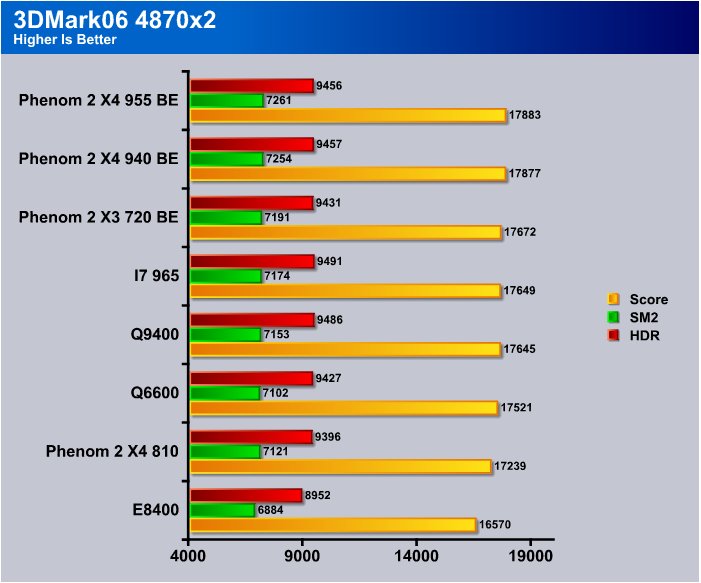
As you can see from a graphics standpoint, the top three CPU’s in our chart are all Phenom 2 and all the machines ran the 4870×2 like champions. So, if you’re looking at the Dragon platform from a graphics or gaming standpoint, you’re not going to get hurt using it. The closest price point comparison we have for the Phenom 2 X4 955 BE is the Q9400, but in this case, the Phenom 2 X4 platform even topped the Core i7 platform.
3DMark Vantage
For complete information on 3DMark Vantage Please follow this Link: www.futuremark.com/benchmarks/3dmarkvantage/features/
The newest video benchmark from the gang at Futuremark. This utility is still a synthetic benchmark, but one that more closely reflects real world gaming performance. While it is not a perfect replacement for actual game benchmarks, it has its uses. We tested our cards at the ‘Performance’ setting.
Currently, there is a lot of controversy surrounding NVIDIA’s use of a PhysX driver for its 9800 GTX and GTX 200 series cards, thereby putting the ATI brand at a disadvantage. Whereby installing the PyhsX driver, 3DMark Vantage uses the GPU to perform PhysX calculations during a CPU test, and this is where things get a bit gray. If you look at the Driver Approval Policy for 3DMark Vantage it states; “Based on the specification and design of the CPU tests, GPU make, type or driver version may not have a significant effect on the results of either of the CPU tests as indicated in Section 7.3 of the 3DMark Vantage specification and white paper.” Did NVIDIA cheat by having the GPU handle the PhysX calculations or are they perfectly within their right since they own Ageia and all their IP? I think this point will quickly become moot once Futuremark releases an update to the test.
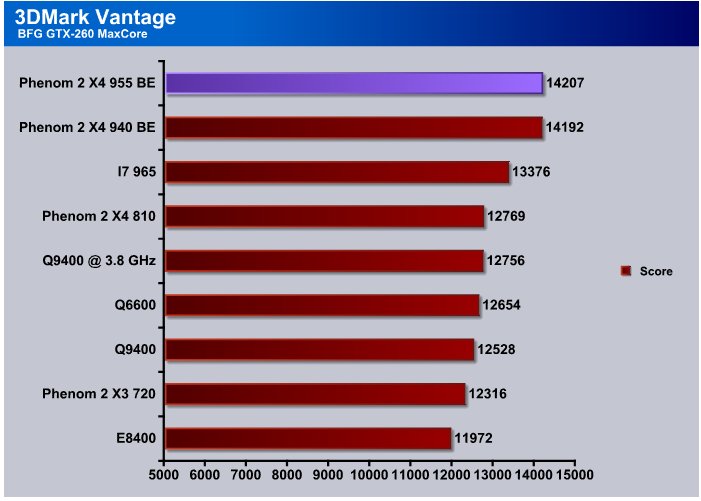
Now for Vantage we swapped out for the BFG GTX-260 MaxCore because we wanted to represent the Dragon platform in 3DMark06 but we also wanted to show that it will also run Nvidia GPU’s just as well. The X4 955 BE tops the chart with an astounding score of 14207 in Vantage.
Cinebench
“CINEBENCH is a real-world test suite that assesses your computer’s performance capabilities. MAXON CINEBENCH is based on MAXON’s award-winning animation software, CINEMA 4D, which is used extensively by studios and production houses worldwide for 3D content creation. MAXON software has been used in blockbuster movies such as Spider-Man, Star Wars, The Chronicles of Narnia and many more. MAXON CINEBENCH runs several tests on your computer to measure the performance of the main processor and the graphics card under real world circumstances. The benchmark application makes use of up to 16 CPUs or CPU cores and is available for Windows (32-bit and 64-Bit) and Macintosh (PPC and Intel-based). The resulting values among different operating systems are 100% comparable and therefore very useful with regard to purchasing decision-making. It can also be used as a marketing tool for hardware vendors or simply to compare hardware among colleagues or friends.”
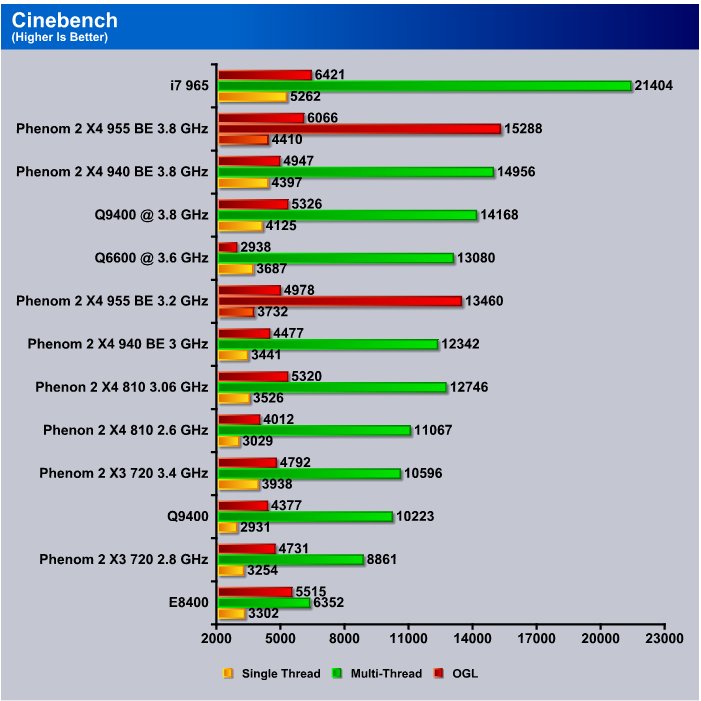
We’re not going to let the cat out of the bag just yet on our maximum OC on the Phenom 2 X4 955 BE. We had a lot of data in the 3.6 to 3.8 GHz range so we clocked the X4 055 BE up to 3.8 GHz so we could have more of a clock for clock comparison. We left the 955 BE side by side with the 940 BE, and at stock clocks you can see the X4 955 outperforms the X4 940 BE at stock speeds. Notice that the X4 955 BE AT STOCK SPEED is also outperforming the Q6600 with the Q6600 running at 3.6 GHz and comes close to the Q9400 with the Q9400 clocked to 3.8 GHz. When we hit the 3.8 GHz OC, the only thing on our charts that beat it is the much more expensive Core i7 965 Extreme. If AMD gets any better we’re going to have to bring another 920 into the mix so we can see how the X4 series compares to the i7 920. From a day to day use standpoint, we really can’t tell any performance difference between i7 and Phenom 2, except the cost, of course.
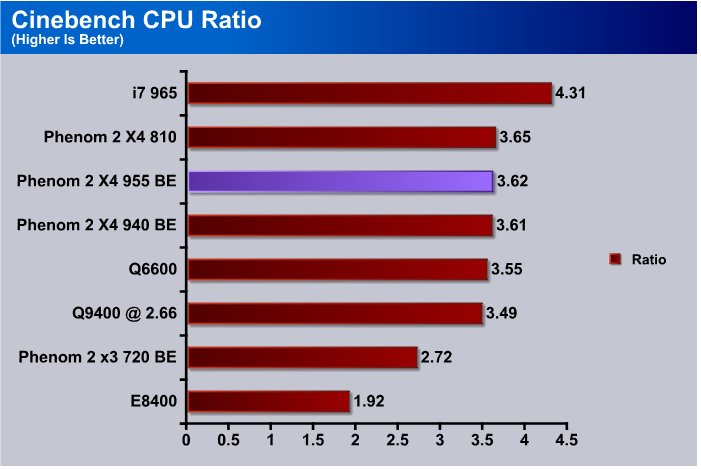
The CPU Ratio test in Cinebench shows how much of the CPU you’re actually using because in multicore CPU’s the cores have to work cooperatively and you lose some efficiency in that process. We made several runs at the Ratio test and averaged the results. We’re seeing 3.62 for the ratio, meaning that we’re a mere .38 short of 4 full cores being utilized.
WinRar v. 3.71
This module in WinRar generates random data, which contains specially introduced redundancy, increasing the load to both the processor and memory. Data is then passed through RAR compression and decompression algorithms, and the output of the decompression algorithm is compared to the source data. If any differences are found, WinRAR then reports “Errors found – Yes” in the command window. WinRAR displays a size of processed data and compression speed, current and resulting, in kilobytes per second.

In WinRar we see the Phenom 2 X4 955 topping the Q9400 running at 3.8 GHz while the X4 955 is running at stock speed. The Phenom 2 X4 955 BE just gets better with the 3.8 GHz OC. You can also see why it’s the flagship chip now, because with the X4 940 clocked to 3.8 GHz the X4 955 at stock speed tops its older brethren.
EVEREST ULTIMATE
“EVEREST Ultimate Edition is an industry leading system diagnostics and benchmarking solution for enthusiasts PC users, based on the award-winning EVEREST Technology. During system optimizations and tweaking it provides essential system and overclock information, advanced hardware monitoring and diagnostics capabilities to check the effects of the applied settings. CPU, FPU and memory benchmarks are available to measure the actual system performance and compare it to previous states or other systems. Furthermore, complete software, operating system and security information makes EVEREST Ultimate Edition a comprehensive system diagnostics tool that offers a total of 100 pages of information about your PC.”
Everest Memory
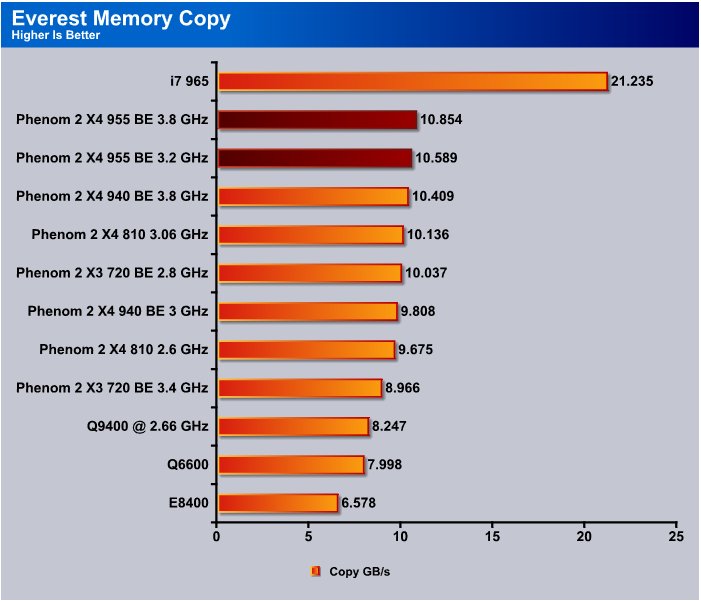
Once again we see that the only thing topping the X4 955 is the triple channel memory of Core i7 and the DDR3 1333 comes in at 10.854 GB/s bandwidth using our CPU Multiplier OC. You can get more bandwidth with a FSB OC but this is an unlocked multiplier CPU, so we used a CPU multiplier OC for the review.
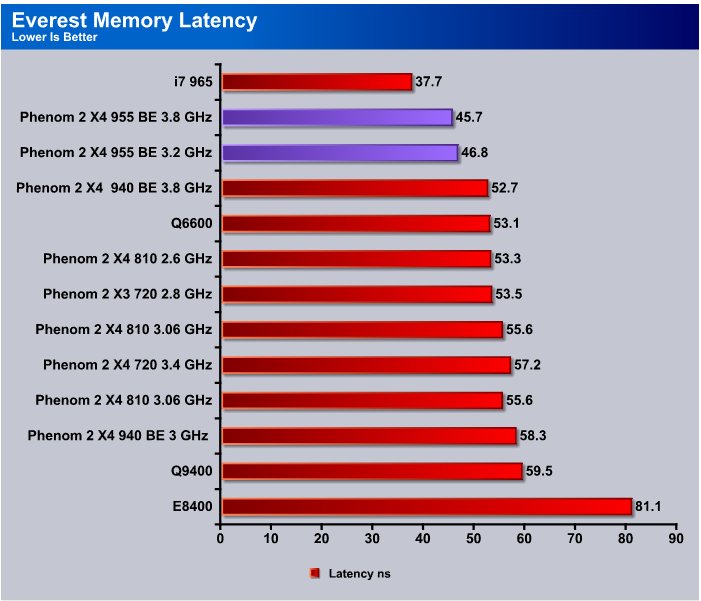
If you will notice the Latency on the X4 CPU’s using DDR2 is down in the mid 50 NS range. Running DDR3, the X4 955 is in the mid 40 ns range so the DDR3 is making a difference for this platform.
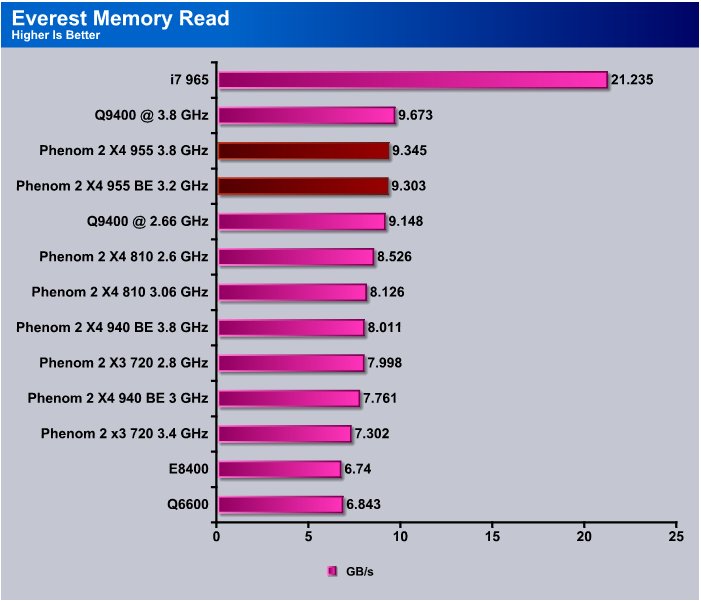
We really wish we had more than the one short week of good testing time on the X4 955 BE but still we got a 9.345 GHz in the Memory Read Test.
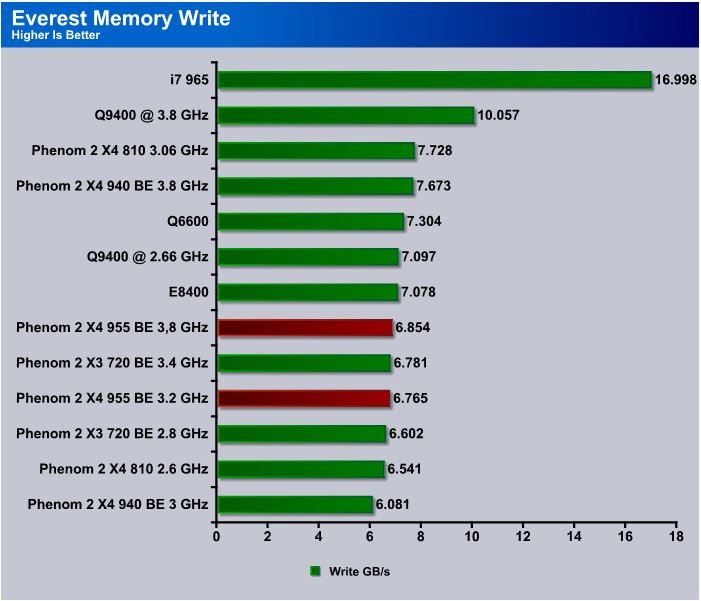
The memory write test had us up until late at night and no matter the configurations we tried the X4 955 BE dropped significantly in the charts, which doesn’t seem right. If we get any updated info we’ll pass it along here.
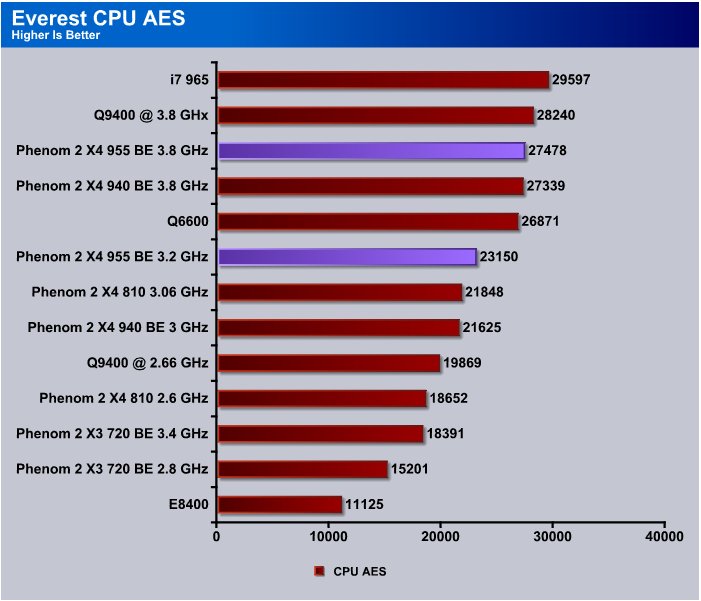
In the Everest CPU AES test the Q9400 edges out the X4 955 but the Q9400 was a FSB OC so you get a little better performance from that type of OC. The X4 955 BE offers the ease of a CPU Multiplier OC for close to the same price as the Q9400.

When it came to the PhotoWorxx test in Everest the only thing that tops the X4 955 BE is the Core i7 965 Extreme. That’s not saying much considering the X4 955 will cost less than 1/3 what the 965 Extreme costs.

The CPU Queen test sees the Q9400 and Q6600 topping the X4 955 but again, those are FSB overclocks, so who knows what the X4 955 will do to that lead with a good FSB OC.
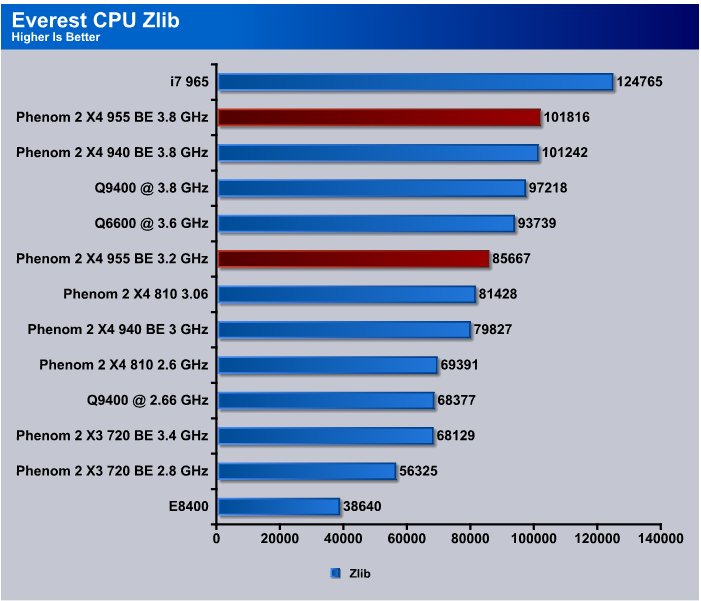
The CPU Zlib test in Everest is pretty sensitive to CPU Speed and again, the only thing we’ve tested that is faster than the Phenom 2 X4 955 (when it’s overclocked) is the Intel Core I7 965 Extreme.
Sisoft Sandra 2009 SP1
“SiSoftware Sandra (the System ANalyser, Diagnostic and Reporting Assistant) is an information & diagnostic utility. It should provide most of the information (including undocumented) you need to know about your hardware, software and other devices whether hardware or software. It works along the lines of other Windows utilities, however it tries to go beyond them and show you more of what’s really going on. Giving the user the ability to draw comparisons at both a high and low-level. You can get information about the CPU, chipset, video adapter, ports, printers, sound card, memory, network, Windows internals, AGP, PCI, PCI-X, PCIe (PCI Express), database, USB, USB2, 1394/Firewire, etc.”
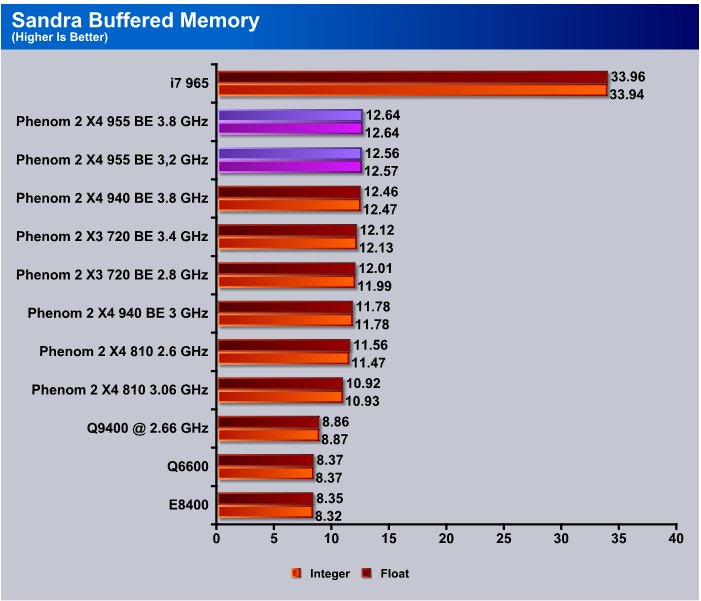
In the Sandra Buffered memory test we see that the only thing shakin’ that beats the Phenom 2 X4 platform is the Triple channel memory of Core i7.
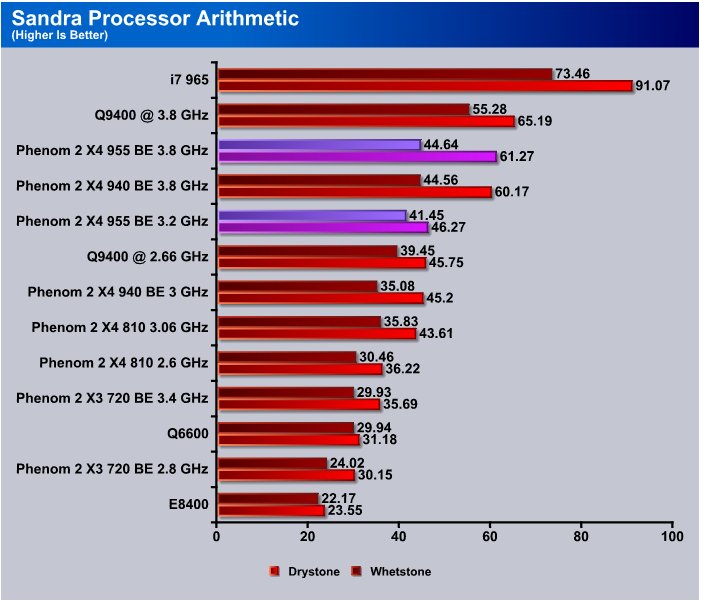
The Q9400 slipped ahead of the Phenom X4 955 BE in the processor arithmetic test in Sandra but it’s funny that we couldn’t notice any real life performance advantage with the Intel platform.
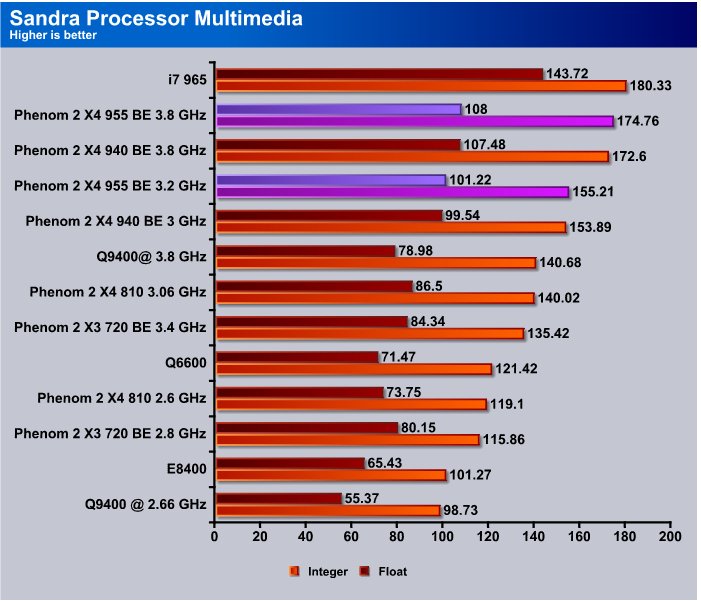
Multimedia and graphics is where the Dragon platform really shines. Performance wise it challenges Core i7 in this test and at the Phenom 2 platforms price it packs the best price performance punch of any Quad platform we’ve seen.
OVERCLOCKING
We covered overclocking methods earlier in the review. AOD (AMD OverDrive) had a new version coming out at the launch of the Phenom 2 X4 955 and we found it extremely useful in overclocking the X4 955. Once we roughed out the settings in AOD we went into BIOS and had the Phenom 2 X4 955 BE overclocked to 3.8 GHz insanely easy. We’re jumping the gun though. Let’s get a look at the Stock CPU-Z shots.
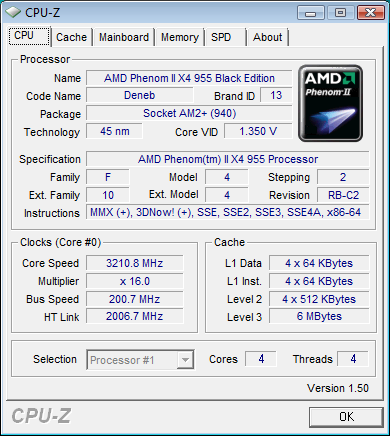
CPU-Z shows the default Multiplier on the Phenom 2 X4 955 BE set at 16 and at this setting it was plug and play.

As you can see, we’re using the Asus M4A78T-E with the all important SB750 that overclocks the Phenoms so well. We hear of a new SB7XX that’s available and as soon as we get hands on one we’ll fire up a review on it.
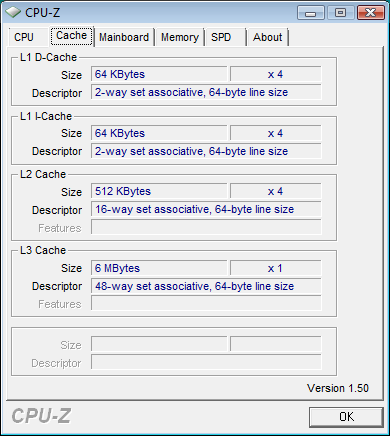
The Cache screen shows the 6 MB L3 cache the X4 955 sports.
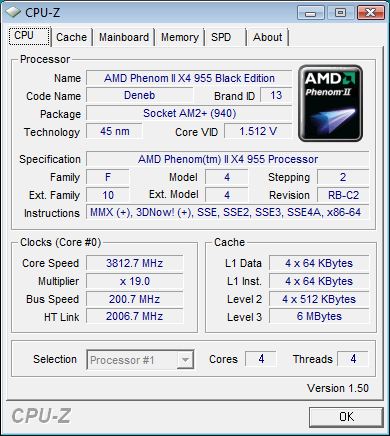
This is the initial stable OC we got on the Phenom 2 X4 955 but we were able to trim some voltage once we had a handle on the platform. At 3.8 GHz your at the point of diminishing returns on voltage.

We had to use all of 1.55v to reach 4 GHz on air stable but you gotta love a CPU that will run 4 GHz on air. It was getting a little toasty at this point and the idle was hitting 45°C, so better cooling is going to be needed for above 3.8 GHz. AMD says 62°C is the thermal limit on this one.
CONCLUSION
The Phenom 2 X4 955 BE offers great performance at a good price. You can use your existing AM2+ board and DDR2 ram then upgrade to AM3 and DDR3, making it an even better choice in economic hard times. If we had to place it inline with current Intel offerings, we’d say it fits roughly in with the Q9400 or Q9500 and is price point competitive with those CPU’s. By that we mean it will perform on the same level as those CPU’s at stock and overclocked speeds.
The Phenom 2 X4 955 isn’t going to unseat the Core i7 CPU’s from their lofty throne but they rival them in some aspects. If we had to go out of pocket for a new rig at this point we’d heavily consider an X4 955. Not only is the CPU less expensive, the motherboards, on average, run about $100 (USD) less. You can snag a mid range AMD board with a SB750 and it’ll clock the unlocked multiplier X4 955 BE just as well as a deluxe board. The Asus M4A78T-E we use isn’t even a high end board and we easily hit 4 GHz.
Speaking of overclocking, the Phenom 2 X4 955 BE overclocked insanely easy. We hit 3.8 GHz in about 15 minutes stable. Getting to 4 GHz took us about an hour, mainly by walking up the voltage on the CPU slowly. The Phenom 2 lineup is an overclocking champion and loves extreme cooling like Dry Ice and LN2, making it a good choice for Air, Water ,and exotic cooling enthusiasts.
We like the easy upgrade path on the Phenom 2 lineup and the price performance punch it offers. Dollar for dollar, we don’t think you’ll find a better platform out there than the Phenom 2 lineup and if you have a few bucks to spare, treat yourself to the Phenom 2 X4 955 BE with it’s unlocked multiplier and overclocking headroom. We love it.
We are trying out a new addition to our scoring system to provide additional feedback beyond a flat score. Please note that the final score isn’t an aggregate average of the new rating system.
- Performance 9
- Value 10
- Quality 10
- Warranty 8
- Features 10
- Innovation 9
Pros:
+ Great Price/Performance
+ Nice Overclocking Headroom
+ Responds Well To Advanced Cooling Methods
+ Best Performance From AMD We’ve Seen To Date
+ Very Stable When Overclocked Properly
+ Fun To Overclock Black Editions
+ Entire Top End Dragon Platform Cheaper Than A Single Intel 965 Extreme CPU.
Cons:
– Hasn’t Caught Up To Intel Core i7
The Phenom 2 X4 955 BE, with it’s clock speed of 3.2 GHz and unlocked multiplier, will be fast enough out of the box for 90% of all people. Put the overclock to it and you’re in for tons of fun and a ride you wouldn’t expect from a platform that offers value pricing with monster performance, so it scores a 9 out of 10 and the Golden Bear Award.
| CPU Name | Cores | Clock | L2/L3 Cache | HT Bus | Socket | TDP | Price |
| AMD Phenom II X4 965 BE | 4 | 3.4GHz | 2+6MB | 4000MHz | AM3 | 140W | $179 |
| AMD Phenom II X4 955 BE | 4 | 3.2GHz | 2+6MB | 4000MHz | AM3 | 125W | $165 |
| AMD Phenom II X4 945 | 4 | 3.0GHz | 2+6MB | 4000MHz | AM3 | 125W | $159 |
| AMD Phenom II X4 925 | 4 | 2.8GHz | 2+6MB | 4000MHz | AM3 | 95W | $139 |
| AMD Phenom II X4 910e | 4 | 2.6GHz | 2+6MB | 4000MHz | AM3 | 65W | $169 |
| AMD Phenom II X4 905e | 4 | 2.5GHz | 2+6MB | 4000MHz | AM3 | 65W | $175 |
| AMD Phenom II X4 810 | 4 | 2.6GHz | 2+4MB | 4000MHz | AM3 | 95W | $139 |
| AMD Phenom II X3 720BE | 3 | 2.8GHz | 1.5+6MB | 4000MHz | AM3 | 95W | $104 |
| AMD Phenom II X3 710 | 3 | 2.6GHz | 1.5+6MB | 4000MHz | AM3 | 95W | $99 |
| AMD Phenom II X3 705e | 3 | 2.5GHz | 1.5+6MB | 4000MHz | AM3 | 65W | $119 |
| AMD Phenom II X2 555 | 2 | 3.2GHz | 1+6MB | 4000MHz | AM3 | 80W | $99 |
| AMD Phenom II X2 550 | 2 | 3.1GHz | 1+6MB | 4000MHz | AM3 | 80W | $91 |
| AMD Athlon II X4 635 | 4 | 2.9GHz | 2MB | 4000MHz | AM3 | 95W | $120 |
| AMD Athlon II X4 630 | 4 | 2.8GHz | 2MB | 4000MHz | AM3 | 95W | $102 |
| AMD Athlon II X4 620 | 4 | 2.6GHz | 2MB | 4000MHz | AM3 | 95W | $99 |
| AMD Athlon II X3 440 | 3 | 3.0GHz | 1.5MB | 4000MHz | AM3 | 95W | $84 |
| AMD Athlon II X3 435 | 3 | 2.9GHz | 1.5MB | 4000MHz | AM3 | 95W | $75 |
| AMD Athlon II X3 425 | 3 | 2.7GHz | 1.5MB | 4000MHz | AM3 | 95W | $72 |
| AMD Athlon II X2 255 | 2 | 3.1GHz | 2MB | 4000MHz | AM3 | 65W | $75 |
| AMD Athlon II X2 250 | 2 | 3.0GHz | 2MB | 4000MHz | AM3 | 65W | $65 |
| AMD Athlon II X2 245 | 2 | 2.9GHz | 2MB | 4000MHz | AM3 | 65W | $61 |
| AMD Athlon II X2 240 | 2 | 2.8GHz | 2MB | 4000MHz | AM3 | 65W | $53 |
 Bjorn3D.com Bjorn3d.com – Satisfying Your Daily Tech Cravings Since 1996
Bjorn3D.com Bjorn3d.com – Satisfying Your Daily Tech Cravings Since 1996





